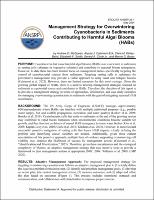Please use this identifier to cite or link to this item:
https://hdl.handle.net/11681/48472| Title: | Management strategy for overwintering cyanobacteria in sediments contributing to harmful algal blooms (HABs) |
| Authors: | McQueen, Andrew D. Calomeni-Eck, Alyssa J. Kinley-Baird, Ciera M. Smith, Elizabeth F. Clyde, Gerard A. Boyer, Marvin G. |
| Keywords: | Algal blooms Cyanobacterial blooms Contaminated sediments Water quality Milford Lake (Kan.) Aquatic Nuisance Species Research Program (U.S.) |
| Publisher: | Engineer Research and Development Center (U.S.) |
| Series/Report no.: | Technical Note (Aquatic Nuisance Species Research Program (U.S.)) ; no. ERDC/TN ANSRP-24-1 |
| Abstract: | Cyanobacteria that cause harmful algal blooms (HABs) can overwinter in sediments as resting cells (akinetes or vegetative colonies) and contribute to seasonal bloom resurgences. However, to date there has been limited focus on management tactics specifically targeting the control of cyanobacterial sources from sediments. Targeting resting cells in sediments for preventative management may provide a viable approach to delay onset and mitigate blooms (Calomeni et al. 2022). However, there are limited resources for this novel strategy. Given the growing global impact of HABs, there is a need to develop management strategies focused on sediments as a potential source and contributor to HABs. Therefore, the objective of this report is to provide a management strategy in terms of approaches, information, and case study examples for managing overwintering cyanobacteria in sediments with the goal of mitigating seasonal HAB occurrences. |
| Description: | Technical Note |
| Gov't Doc #: | ERDC/TN ANSRP-24-1 |
| Rights: | Approved for Public Release; Distribution is Unlimited |
| URI: | https://hdl.handle.net/11681/48472 http://dx.doi.org/10.21079/11681/48472 |
| Appears in Collections: | Technical Note |
Files in This Item:
| File | Description | Size | Format | |
|---|---|---|---|---|
| ERDC-TN ANSRP-24-1.pdf | ERDC/TN ANSRP-24-1 | 1.17 MB | Adobe PDF |  View/Open |